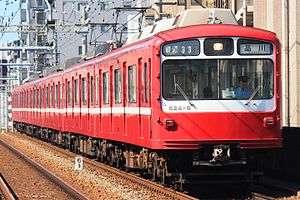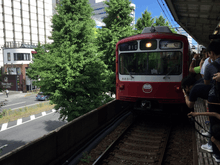Keikyu 800 series
The Keikyu 800 series (京急800形) was an electric multiple unit (EMU) train type operated by the private railway operator Keikyu on commuter services in the Tokyo area of Japan from 1978[1] until 2019.
| Keikyu 800 series | |
|---|---|
 Set 824 in July 2014 | |
| In service | 1978-2019 |
| Manufacturer | Tokyu Car Corporation, Kawasaki Heavy Industries |
| Entered service | 1978 |
| Refurbished | 1994–2001 |
| Scrapped | 2011– |
| Number built | 132 vehicles |
| Number in service | None |
| Number scrapped | 60 vehicles |
| Formation | 6 cars per trainset |
| Operator(s) | Keikyu |
| Depot(s) | Kanazawa, Shinmachi |
| Specifications | |
| Car body construction | Steel |
| Car length | 18,500 mm (60 ft 8 in) (end cars) 17,860 mm (58 ft 7 in) (intermediate cars) |
| Width | 2,798 mm (9 ft 2 in) |
| Doors | 4 per side |
| Maximum speed | 100 km/h (60 mph)[1] |
| Traction system | Chopper |
| Acceleration | 3.5 km/h/s[1] |
| Electric system(s) | 1,500 V DC overhead wire |
| Current collection method | Pantograph |
| Track gauge | 1,435 mm (4 ft 8 1⁄2 in) |
Formations
Initially delivered as three-car sets,[1] as of 1 April 2016, the fleet consisted of 12 six-car sets, formed as follows, with all cars motored (M cars).[2]
| Designation | M1c | M2 | M3 | M1 | M2 | M3c |
|---|---|---|---|---|---|---|
| Numbering | 8xx-1 | 8xx-2 | 8xx-3 | 8xx-4 | 8xx-5 | 8xx-6 |
- The "xx" in the car numbers corresponds to the set number.
- The two "M2" cars are each fitted with two lozenge-type pantographs.[2]
Interior
Passenger accommodation consists of longitudinal bench seating throughout.[1]
- The interior of set 821 in September 2013
 The gangway connection between former cab cars 805-3 and 806-1 in May 2012
The gangway connection between former cab cars 805-3 and 806-1 in May 2012
Liveries
When delivered, the 800 series sets were painted in the standard Keikyu livery of vermillion red with white window surrounds, but were later repainted into all-over vermillion red with a white bodyside stripe following the introduction of the 2000 series trains.[1]
- Three-car set 802 in original livery in January 1983
 Six-car set 813 in later livery in July 2006
Six-car set 813 in later livery in July 2006
Revival livery
In November 2016, set 823 was repainted into the original-style livery with white window surrounds.[3]
 Reliveried set 823 in November 2016
Reliveried set 823 in November 2016
History
The 800 series won the 1979 Laurel Prize from the Japan Railfan Club.
The fleet underwent life-extension refurbishment between 1994 and 2001.[1] This involved upgrading the train interiors and also forming six-car sets from the remaining three-car sets by removing the cab ends and adding gangway connections.[1]
- Former cab cars converted to become gangwayed intermediate cars
Withdrawal

Withdrawals commenced in 2011 following the introduction of new six-car N1000 series sets.[1]
The last train, set 823, made its final run as a special charter on 16 June 2019.[4]
Preserved examples
.jpg)
The cab end of former car DeHa 812-6 is preserved inside the Maruzen Ikebukuro bookshop in Toshima, Tokyo. Built in November 1979 by Kawasaki Heavy Industries, and originally numbered 812-3, it was renumbered 812-6 in August 1986 following reforming as a six-car unit. It was withdrawn in December 2015, and moved to the ground floor of the Maruzen Ikebukuro bookshop building in March 2017, while still under construction.[5]
References
- 私鉄車両年鑑 2012: 大手15社営業用車両完全網羅 私鉄車両年鑑2012 [Japan Private Railways Annual 2012]. Tokyo, Japan: Ikaros Publications Ltd. February 2012. p. 122. ISBN 978-4-86320-549-9.
- 私鉄車両編成表 2016 [Private Railway Rolling Stock Formations - 2016] (in Japanese). Japan: Kotsu Shimbunsha. 25 July 2016. p. 37. ISBN 978-4-330-70116-5.
- 京急800形823編成がリバイバル塗装で出場 [Keikyu 800 series set 823 outshopped in revival livery]. Japan Railfan Magazine Online (in Japanese). Japan: Koyusha Co., Ltd. 3 November 2016. Archived from the original on 4 November 2016. Retrieved 4 November 2016.
- Kusamachi, Yoshikazu (16 June 2019). "京急「だるま電車」800形が引退特別運転 伝統の「ドア」と「ライト」消える" [Keikyu "Daruma Train" 800 series retires special operation, Traditional "door" and "light" disappear]. trafficnews.jp (in Japanese). Mediavague Co., ltd. Archived from the original on 16 June 2019. Retrieved 18 December 2019.
- Goto, Fumio (October 2017). 東京・池袋 ビルに入った3台の電車 [The three trains inside a building in Ikebukuro, Tokyo]. Japan Railfan Magazine (in Japanese). Vol. 57 no. 678. Japan: Koyusha Co., Ltd. p. 78–81.
External links
| Wikimedia Commons has media related to Keikyu 800 series. |
- Keikyu 800 series official information (in Japanese)
